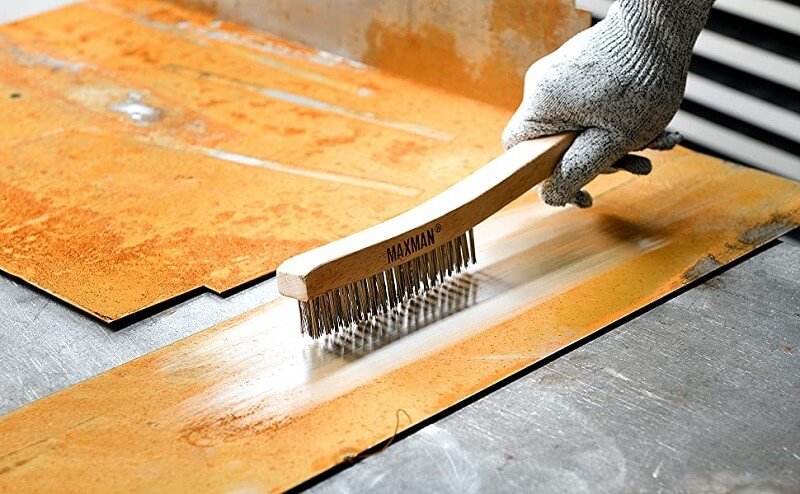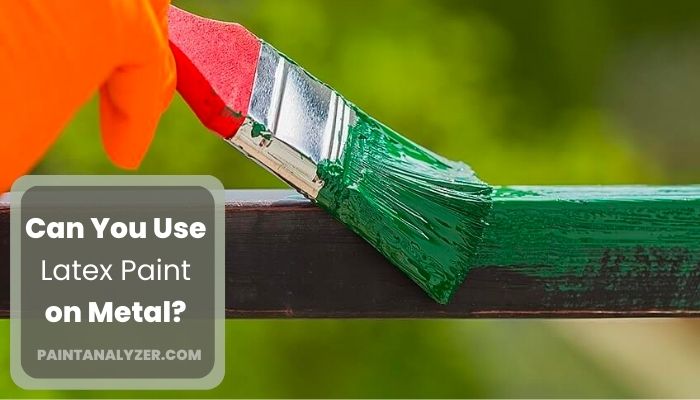Metal objects often become old, rusted, and do not look as nice as they used to. Rather than throwing them in the trash, you can give them a brand-new look by applying new paint.
Most people prefer latex paint to other types because it is affordable, widely available, non-toxic, and easily cleanable.
But can you use latex paint on metal since several paints do not stick to metal surfaces?
Thankfully, yes, it is perfectly fine to use latex on metal items. In fact, it is one of the most recommended paints for its long-lasting adhesion to metal.
However, you cannot brush the latex paint over metal like a regular painting job. In order to ensure long-lasting paint and prevent denting, rusting, and fading, you should prepare the metal surface prior to painting.
In this article, we will discuss the effective methods to prepare the metal, and then we will move on to how to apply the paint to the metal correctly.
Preparing Metal for the Latex Paint

The main purpose of preparing metal is to remove dirt, grease, stains, and previous paint. We will apply the primer in the final step to improve the adhesive capabilities so that the color does not wear off after a few days.
Required Items –
● Sponge
● Water
● Wire Brush or Hard Brush or Metal Scraper
● Primer
1. Cleaning the Dust
You may skip cleaning the metal if it is new and hardly dusty.
However, old metal objects usually have a lot of dust and dirt on them. If this is the case, you must clean the metal first.
You should use regular water and a sponge to clean the metal. Avoid using any types of detergents as they can damage the material. If the metal is portable, you should move it outdoors to let it dry fast.
2. Getting Rid of Grease
Not every metal will have grease on it. However, if it does, you must wash the grease off the surface before painting it. Mineral spirits are the best in business when it comes to removing grease.
3. Setting up the Workspace
As the metal is drying, you have plenty of time on your hands. Make use of this time to prepare the area where you will sand, scrape, and paint the metal on.
Lay a plastic wrap on the floor. We strongly recommend you do this, especially if your floor is wooden. Despite the fact that latex paint comes off easily, it can be a bit stubborn on hardwood floors. The plastic wrap will collect the paint splashes, allowing you to remove them while cleaning easily.
If you have electronic devices in the room, even a single drop of paint can damage them. Take those items off the workspace.
4. Removing Existing Paint
There could be paint already on the metal. If you do not remove the previous paint and proceed with latex paint, it may not adhere properly to the metal. The ideal way to remove old paint is to scrape it off the surface.
We found wire brushes to be the most useful tool for scraping. This is because they can easily scrape off existing paint and stains from your metal with heavy-duty bristles.
A wire brush also offers excellent flexibility, allowing the user to reach corners and narrow areas for a smooth finish.
If you do not have a wire brush, a metal scraper or hard brush would be a suitable substitute for scraping. Whatever option you choose, try to remove as much paint and stain as you can.
5. Sanding the Surface
Scraping alone will not give you a flawless metal surface. No matter how well you scrape, some particles will remain. This is where sanding shines the most. It does not leave a single mark on the metal. This significantly enhances the adhesive properties.
You can sand metal with either 50-grit or 60-grit without any issues. Some people like to sand all the way to get the cleanest finish. Hence, they use fine sandpapers with grits that range from 120 to 220.
If you are one of the above-mentioned folks, you may notice that fine sandpaper leaves the surface excessively rough. This indicates that the sanding went well.
6. Using Primer
Last but certainly not least, you should prime the surface. Applying primer before painting the metal plays a key role in its preparation. Besides increasing the adhesive properties, it also provides a long-lasting and appealing finish.
The method of priming metal is the same as painting it; the primer is directly applied to the metal. Having said that, it is best to follow the instructions that come with primer.
We suggest applying two coats of primer to the surface. The instructions should tell you how long the primer needs to dry. Then, you can proceed with painting the metal with latex paint.
Related: Can You Paint Enamel Over Latex?
Will Using Polyurethane Over Latex Paint on Metal Have Any Negative Effects?
Yes, putting polyurethane over paint, particularly over latex paint on metal, can have negative effects. Polyurethane may not adhere well to the latex paint and could lead to cracking, peeling, or flaking over time. It’s best to use a suitable primer and paint designed for metal surfaces instead.
How to Use Latex Paint On Metal?
If you have followed the above steps and prepared the metal object accordingly, now is the right time to latex paint it. Here are the tools you will need to do the job.
Required Items –
● Latex Paint
● Paint Roller or Paintbrush
● Wax (optional)
1. Preparing the Paint
One of the biggest advantages of latex paint is that it does not require any prep work. You should, however, check the manual to determine whether the latex you bought needs special processing or not.
Once you have followed the instructions, you are all set to start applying the paint.
2. Drying the Primer
Many painters make the rookie mistake of putting latex on the material before the primer is dried. It must be fully cured/dried before applying latex. After that, you can move on to the next step.
3. Intensity of Coating
You should paint metal at least twice due to its hardness. This means two layers or coats of latex paint should suffice. However, sometimes painters apply three layers to be on the safe side.
It is important to note that after the first coat of paint, it needs to dry completely. Once the initial layer has been fully dried, apply the second layer.
Repeat this procedure if you intend to apply the third layer.
4. Painting Supplies
If you are painting metal objects, you should always use a paint brush or roller, but never use a spray gun if you are new at this.
While painting with a sprayer, you will have to follow a number of additional instructions. It is even more cumbersome since you are painting metal.
5. Covering All Areas
Scraping and sanding will enable you to reach all the corners and gaps on the metal object. Be sure to roll your paintbrush on these areas.
Materials made from metal are extremely glossy. If some areas are left untouched after applying latex paint, the bare spots will be clearly visible, making the paint look bad.
6. Using Wax (If Necessary)
When you paint outdoor metal furniture with latex, it will likely be exposed to rain and the heat of the sun. There is a possibility that the paint will start to peel off after a few days due to the harsh weather conditions.
We just have the perfect solution to this problem. Put a coat of wax over the paint (or two, if it is possible). This will make the color more durable and attractive.
How Long Does Latex Paint Take to Dry on Metal?
Water-based latex usually dries faster than all types of paint. When latex is in contact with metal, the drying process is even faster. It is because the metal’s cold nature makes the solvent evaporate rapidly. In this way, the paint dries approximately in 15 minutes (suitable for touching).
Despite the fact that you can touch the latex without smearing it, the paint is not yet ready for a second coat. It takes about an hour for the first coat to cure fully. You can then apply another layer over the existing latex paint.
It is extremely important that you wait until the first coat has fully cured before applying the second one. Essentially, the first layer is the foundation. Poor adhesion of this layer to the metal surface can ruin the whole latex painting process.
Related: How Long Does Acrylic Paint Take to Dry?

Final Words
So, can you use latex paint on metal? The answer is yes. But you need to perform the preliminary steps as described in the article. The metal must be cleaned, sanded, and primed. While painting, you also have to use a specific set of tools such as the paint roller or paintbrush.
You must keep in mind that latex is a water-based paint. It can cause rust on metal if the surface is not prepared correctly. Hence, carefully prepare the metal object and apply latex paint to it.